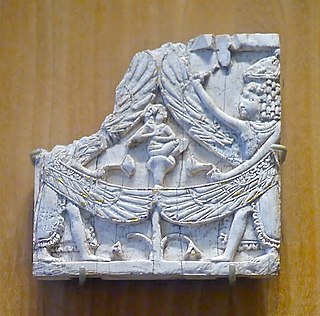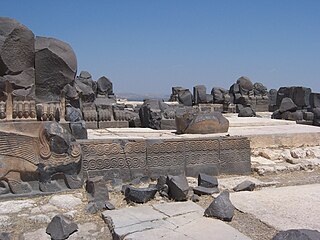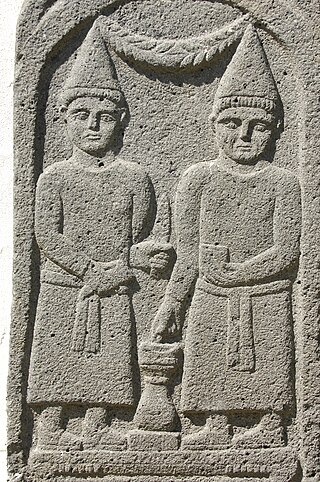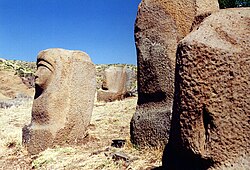
Lama, Lamma, or Lamassu is an Assyrian protective deity.

Gaziantep Province is a province in south-central Turkey. It is located in the westernmost part of Turkey's Southeastern Anatolia Region and partially in the Mediterranean Region. Its capital is the city of Gaziantep. It neighbours Adıyaman to the northeast, Şanlıurfa to the east, Syria and Kilis to the south, Hatay to the southwest, Osmaniye to the west and Kahramanmaraş to the northwest.

Carchemish, also spelled Karkemish was an important ancient capital in the northern part of the region of Syria. At times during its history the city was independent, but it was also part of the Mitanni, Hittite and Neo-Assyrian Empires. Today it is on the frontier between Turkey and Syria.

Aram was a historical region mentioned in early cuneiforms and in the Bible. The area of Aram did not develop into a bigger empire, it consisted of a number of small states in present-day Syria and northern Israel. Some of these states are mentioned in the Old Testament, Damascus being the most outstanding one, which came to encompass most of Syria. Furthermore, Aram-Damascus is commonly referred to as simply Aram in the Old Testament.

Samʼal, also Yaʼdiya or Zincirli Höyük, is an archaeological site located in the Anti-Taurus Mountains of modern Turkey's Gaziantep Province. It was founded at least as far back as the Early Bronze Age and thrived between 3000 and 2000 BC, and on the highest part of the upper mound was found a walled citadel of the Middle Bronze Age. New excavations revealed a monumental complex in the Middle Bronze Age II, and another structure that was destroyed in the mid to late 17th century BC, maybe by Hititte king Hattusili I. It was thought to have been abandoned during the Hittite and Mitanni periods, but excavations in 2021 season showed evidence of occupation during the Late Bronze Age in Hittite times. It flourished again in the Iron Age, initially under Luwian-speaking Neo-Hittites, and by 920 B.C. had become a kingdom. In the 9th and 8th century BC it came under control of the Neo-Assyrian Empire and by the 7th century BC had become a directly ruled Assyrian province.
Kadirli, formerly called Kars, is a town and district of Osmaniye Province in the Mediterranean region of Turkey. It is located in the Çukurova plain, 41 kilometres from the large city of Osmaniye. Population is 84,618 (urban) and 120,950. It is located near the ancient site of Flaviopolis.

The Museum of Anatolian Civilizations is located on the south side of Ankara Castle in the Atpazarı area in Ankara, Turkey. It consists of the old Ottoman Mahmut Paşa bazaar storage building, and the Kurşunlu Han. Because of Atatürk's desire to establish a Hittite museum, the buildings were bought upon the suggestion of Hamit Zübeyir Koşay, who was then Culture Minister, to the National Education Minister, Saffet Arıkan. After the remodelling and repairs were completed (1938–1968), the building was opened to the public as the Ankara Archaeological Museum.

Arslan Tash, ancient Hadātu, is an archaeological site in Aleppo Governorate in northern Syria, around 30 kilometres (19 mi) east of Carchemish and the Euphrates and nearby the town of Kobanî.

The Ain Dara temple is an Iron Age Syro-Hittite temple noted for its similarities to Solomon's Temple, also known as the First Temple, as described in the Hebrew Bible. It is located near the village of Ain Dara, in Afrin, Syria. According to the excavator Ali Abu Assaf, it existed from 1300 BC until 740 BC and remained almost unchanged during the construction of Solomon's Temple as it had been before, so that it predates the Temple. The temples of Emar, Mumbaqa, and Ebla are also comparable, as is the nearby 8th-century Tell Tayinat temple. The surviving sculptures depict lions and sphinxes.

Iberian sculpture, a subset of Iberian art, describes the various sculptural styles developed by the Iberians from the Bronze Age up to the Roman conquest. For this reason it is sometimes described as Pre-Roman Iberian sculpture.

The ancient Near East was the home of early civilizations within a region roughly corresponding to the modern Middle East: Mesopotamia, ancient Egypt, ancient Iran, Anatolia/Asia Minor and the Armenian highlands, the Levant, Cyprus and the Arabian Peninsula. The ancient Near East is studied in the fields of Ancient Near East studies, Near Eastern archaeology and ancient history.

The National Museum of Aleppo is the largest museum in the city of Aleppo, Syria, and was founded in 1931. It is located in the heart of the northern city on Baron Street, adjacent to the famous Baron Hotel and near the Bab al-Faraj Square and Clock Tower. The majority of the museum's exhibitions are devoted to the archaeology of Syria, with most of the finds coming from archaeological sites of the northern part of the country.

The Gaziantep Museum of Archaeology is an archaeological museum located in the city of Gaziantep, Turkey. It housed for some years a collection of mosaics, most of which were excavated from the ancient Roman city site of Zeugma. A new museum, the Zeugma Mosaic Museum now houses those. After an overhaul of the displays the museum now houses a fine collection of finds from the region. Exhibits include a collection of paleolithic artifacts; items from a Bronze Age necropolis; Hittite, Persian, Roman, Hellenistic, and Commagene artworks and glassware; Ottoman and Islamic coins and medallions; and the skeleton of a mammoth. Attached to the museum is a garden containing a selection of stone artifacts, including pagan tombstones from Zeugma, Christian tombstones, and Hittite statuary.
Tell Afis is an archaeological site in the Idlib region of northern Syria, and lies about fifty kilometres southeast of Aleppo. The site is thought to be that of ancient Hazrek capital of Luhuti.

A rock relief or rock-cut relief is a relief sculpture carved on solid or "living rock" such as a cliff, rather than a detached piece of stone. They are a category of rock art, and sometimes found as part of, or in conjunction with, rock-cut architecture. However, they tend to be omitted in most works on rock art, which concentrate on engravings and paintings by prehistoric peoples. A few such works exploit the natural contours of the rock and use them to define an image, but they do not amount to man-made reliefs. Rock reliefs have been made in many cultures throughout human history, and were especially important in the art of the ancient Near East. Rock reliefs are generally fairly large, as they need to be in order to have an impact in the open air. Most of those discussed here have figures that are over life-size, and in many the figures are multiples of life-size.

Karatepe-Aslantaş Open-Air Museum is an open-air museum in Osmaniye Province, Turkey. Karatepe is the location while Aslantaş refers to the lion figure on stone sculptures. The site is situated inside a national park with the same name.
Uluğ Bahadır Alkım was a Turkish archaeologist.

Assyrian sculpture is the sculpture of the ancient Assyrian states, especially the Neo-Assyrian Empire of 911 to 612 BC, which was centered around the city of Assur in Mesopotamia which at its height, ruled over all of Mesopotamia, the Levant and Egypt, as well as portions of Anatolia, Arabia and modern-day Iran and Armenia. It forms a phase of the art of Mesopotamia, differing in particular because of its much greater use of stone and gypsum alabaster for large sculpture.

Hittite art was produced by the Hittite civilization in ancient Anatolia, in modern-day Turkey, and also stretching into Syria during the second millennium BCE from the nineteenth century up until the twelfth century BCE. This period falls under the Anatolian Bronze Age. It is characterized by a long tradition of canonized images and motifs rearranged, while still being recognizable, by artists to convey meaning to a largely illiterate population.
“Owing to the limited vocabulary of figural types [and motifs], invention for the Hittite artist usually was a matter of combining and manipulating the units to form more complex compositions"

Tilmen Höyük is an archaeological mound located near the town of Islahiye, in the Gaziantep province of Turkey. It is 225 meters in diameter and 21 meters high on the shores of Karasu River. It is located on the western edge of the Sakçagözü Plain. It is very near the Amanos Mountains.





















